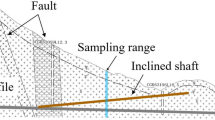Summary
The deformation of a competent, brittle, granitic rock is thought to have two main components: elastic and brittle deformation, the latter caused by axial microcracking. Dynamic fatigue testing of Lac du Bonnet granite would, however, suggest the presence of a third mechanism, compaction. Compaction is not the same as elastic crack closure; compaction entails permanent damage along grain boundaries that are under high compression. During compaction, the axial stiffness (elastic modulus) of the rock increases and the permanent crack volume becomes negative (compression). Compaction is active at all stress levels, but it is most noticeable at low stress where its presence is not masked by dilation caused by axial microcracking.
Similar content being viewed by others
Author information
Authors and Affiliations
Rights and permissions
About this article
Cite this article
Lajtai, E. Microscopic Fracture Processes in a Granite. Rock Mech Rock Engng 31, 237–250 (1998). https://doi.org/10.1007/s006030050023
Issue Date:
DOI: https://doi.org/10.1007/s006030050023




